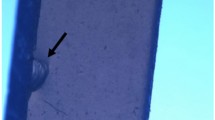Abstract
The effect of the chemical nature of the crosslinks on the fatigue crack growth behavior of filled natural rubber has been investigated. By varying the ratio of sulfur to accelerator, the relative amounts of polysulfidic to monosulfidic crosslinks was controlled. Carbon-carbon crosslinking was introduced via peroxide cure. All elastomers tested were prepared at the same number average crosslink density as confirmed by equilibrium swelling and modulus measurements. At the same crosslink density, polysulfidic crosslinks were most resistant to fatigue over the range of tearing energies investigated. Vulcanizates with primarily monosulfidic crosslinks exhibited lower cut growth rates than peroxide cured specimens, although the monosulfidic network strength may have been enhanced by the presence of some polysulfidic crosslinks.
Résumé
On a étudié l'effet de la nature chimique des liaisons dans le caoutchouc naturel sur son comportement à la propagation des fissures de fatigue. On contrôle la quantité relative de liaisons polysulfurées par rapport aux liaisons monosulfurées en faisant varier le rapport soufre-accélérateur de réaction. Par une vulcanisation sous peroxyde, on peut introduire des liaisons C-C. Tous les élastomères soumis à essais ont été préparés une même valeur moyenne de densité de liaisons, ce qui est confirmé par le gonflement à l'équilibre et par des mesures de module. A même densité de liaison, les liaisons polysulfurées se révèlent les plus résistantes en fatigue, sur la gamme des énergies d'arrachement étudiée. Des composants vulcanisés à liaisons principalement monosulfuruées ont montré des vitesses de croissance d'une entaille plus faibles que des éprouvettes vulcanisées sous peroxyde, bien que la résistance du réseau mono-sulfuré puisse avoir été accrue par la présence de quelques liaisons polysulfurées.
Similar content being viewed by others
References
G.J. Lake and A.G. Thomas, Proceedings Royal Society (London) A300 (1967) 108.
A.K. Bhowmick, A.N. Gent and C.T.R. Pulford, Rubber Chemistry and Technology 56 (1983) 226.
M.J. Wang and F.N. Kelley, unpublished report (1986).
C.M. Kok and V.H. Yee, European Polymer Journal 22 (1986) 341.
L.C. Bateman et al. in The Chemistry and Physics of Rubber-Like Substances, John Wiley and Sons, New York (1963) 715.
J. Lal, Rubber Chemistry and Technology 43 (1970) 664.
H.W. Greensmith et al., in The Chemistry and Physics of Rubber-Like Substances, John Wiley and Sons, New York (1963) 249.
L.C. Yanyo and F.N. Kelley, Rubber Chemistry and Technology 60 (1987) 78.
J.A. Brydson, Rubber Chemistry, Applied Sciences, London (1978).
D.S. Pearson and G.G.A. Bohm, Rubber Chemistry and Technology 45 (1972) 193.
R.F. Fedors and R.F. Landel, Transactions Society of Rheology 9.1 (1965) 195.
A.A. Griffith, Philosophical Transactions Royal Society (London) A221 (1921) 163.
A.A. Griffith, Proceedings International Congress of Applied Mechanics (1924) 55.
R.S. Rivlin and A.G. Thomas, Journal of Polymer Science 10 (1953) 291.
P.B. Lindley and S.C. Teo, Plastics and Rubber: Materials and Applications (1979) 29.
G.J. Lake and P.B. Lindley, in Physical Basis of Yield and Fracture: Conference Proceedings, The Institute of Physics and The Physical Society (1966) 176.
A.N. Gent, P.B. Lindley, and A.G. Thomas, Journal of Applied Polymer Science 8 (1964) 455.
A. Stevenson, Rubber Chemistry and Technology 59 (1986) 208.
A. Ahagon, A.N. Gent, H.J. Kim and Y. Kumagai, Rubber Chemistry and Technology 48 (1975) 896.
E.H. Andrews, Journal of the Mechanics and Physics of Solids 11 (1963) 231.
G.J. Lake and P.B. Lindley, Journal of Applied Polymer Science 9 (1965) 1233.
G.J. Lake and P.B. Lindley, Journal of Applied Polymer Science 10 (1966) 343.
P.B. Lindley, International Journal of Fracture 9 (1973) 449–462.
A.N. Gent and R.H. Tobias, Journal of Polymer Science: Polymer Physics Edition 20 (1982) 2051.
L.C. Yanyo and F.N. Kelley, Rubber Chemistry and Technology 60 (1987) 78.
G.J. Lake and P.B. Lindley, Journal of Applied Polymer Science 8 (1964) 707.
A.R. Payne and R.E. Whittaker, Journal of Applied Polymer Science 15 (1971) 1941.
P.J. Flory, in Principles of Polymer Chemistry, Cornell University Press, Ithaca, NY (1953) 579.
G. Kraus, Rubber World 135 (1956) 67.
B. Saville and A.A. Watson, Rubber Chemistry and Technology 40 (1967) 100.
M.L. Studebaker and L.G. Nabor, Rubber Chemistry and Technology 40 (1967) 100.
M.L. Studebaker and L.G. Nabor, in Proceedings International Rubber Conference, Washington (1959) 237.
A.Y. Coran, Rubber Chemistry and Technology 37 (1964) 668.
J.E. Mark and M.Y. Tang, Journal of Polymer Science: Polymer Physics Edition 22 (1984) 1849.
J.E. Mark, Polymer Journal 17 (1985) 265.
Author information
Authors and Affiliations
Rights and permissions
About this article
Cite this article
Yanyo, L.C. Effect of crosslink type on the fracture of natural rubber vulcanizates. Int J Fract 39, 103–110 (1989). https://doi.org/10.1007/BF00047443
Received:
Accepted:
Issue Date:
DOI: https://doi.org/10.1007/BF00047443




